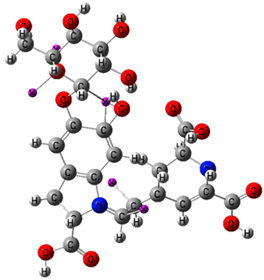High Performance Dye Sensitized Solar Cells by Plasmonic Enhancement of Silver Nanoparticles in ZnO Photoelectrode with Betanin Pigment
Keywords:
Betanin, Plasmonic, DSSC, NanoparticleAbstract
Metal nanoparticles (NPs) introduced in sensitive places in Dye Sensitized Solar Cells (DSSCs) has demonstrated superior performance due to surface plasmon resonance effect. Herein, a systematic investigation by introducing plasmonic silver nanoparticles (AgNPs) in the photoanode of DSSCs with Zinc oxide (ZnO) is investigated. The broadening of the absorption band in the visible region is made possible using the natural pigments betanins. The combined effect of UV-visible absorption spectroscopy, XRD technique, SEM and solar simulator were used to explore the surface plasmon resonance effect. The ZnO photoanode without Ag- NPs shows a Power Conversion Efficiency (PCE) of 0.156 %, Current Density (Jsc) of 0.477 mAcm-2, Open Circuit Voltage (Voc) of 0.762 V and Fill Factor (FF) of 0.431. On coating AgNPs on the pristine photoanode, the PCEs were improved significantly as compared with the pure ZnO based device. The AgNPs were deposited in cycles (2 cycles, 4 cycles and 6 cycles). The device with 2 cycles of Ag NPs, shows a PCE of 0.373 % which demonstrates an enhancement of 2.39 times to that of the prestine device.Also depositing 4 cycles of AgNPs results to PCE of 0.290 % which shows a leading of 0.134 % ahead of the reference PCE. With 6 cycles of AgNPs deposited on the photoanode of bare ZnO NPs, it results to PCE of 0.244%, FF of 0.592, Jsc of 0.572 mAcm-2 and Voc of 0.722 V which also shows an enhancement of - 1.56 times, 1.37 times and 1.20 times in PCE, FF and Jsc over the device lacking AgNPs. These results show significant increment in performances of all the devices with silver inclusion. The performance is attributed to the reduced recombination of electron–hole pairs due to the Ag-ZnO junction and the generation of intense electric fields at the immediate vicinity of the sensitizer, resulting in enhanced light absorption.

Published
How to Cite
Issue
Section
Copyright (c) 2022 Eli Danladi, Muhammad Y. Onimisi, Reuben M. Laah, Imosobomeh L. Ikhioya

This work is licensed under a Creative Commons Attribution 4.0 International License.
How to Cite
Similar Articles
- A. Babangida, J. B. Yerima, A. D. Ahmed, S. C. Ezike, Strategy to Select and Grade Efficient Dyes for Enhanced Photo-Absorption , African Scientific Reports: Volume 1, Issue 1, April 2022
- A. A. Ibiyemi, J. I. Lawal, S. K. Aminu, A. G. Adewole, B. M. Akinroye, A. C. Adeniran, O. A. Abulude, pH treatment on the optical and structural properties of niobium vanadium pentoxide nanoparticles for optoelectronics and energy storage applications , African Scientific Reports: Volume 4, Issue 2, August 2025
You may also start an advanced similarity search for this article.




